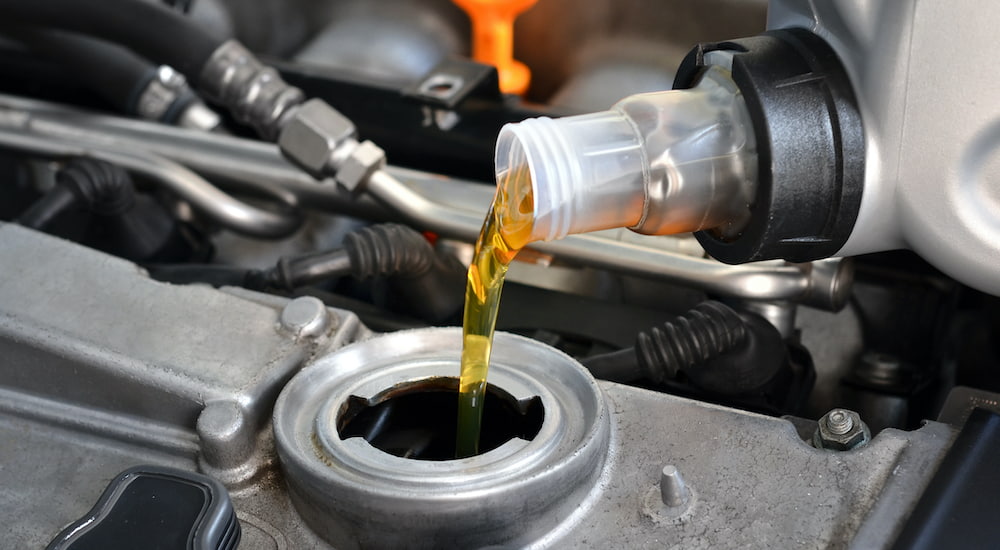If you are a regular reader of Check Engine, then you are likely well aware of the importance of good oil in keeping your engine running smoothly. However, today we are going to go a bit deeper into understanding an important aspect of oil – viscosity ratings. On the surface, this may seem like a simple concept, and you’re probably wondering how much you actually need to know. Most people will get along just fine as long as they make sure the viscosity numbers on the bottle match the numbers recommended in their owner’s manual. But oil viscosity is actually a deceptively simple concept, and it’s possible to get more out of your engine if you understand what those viscosity numbers signify.
What Is Viscosity?
Before delving into the specific traits of engine oil, let’s start with the basics. Simply put, viscosity is a measure of how easily a fluid flows. A low viscosity liquid would be something like water, which flows freely and requires little energy to stir. A high viscosity liquid would be something like honey, which flows slowly and requires a lot of energy to stir. However, it needs to be remembered that viscosity is not a constant – it changes depending on the temperature of the liquid in question. This is a rather intuitive detail that lies behind the common saying “as slow as molasses in January,” but it is important to keep in mind that the colder the temperature of the fluid, the higher its viscosity.
Technically, there are actually two different types of viscosity: kinematic viscosity and dynamic viscosity. Dynamic (also referred to as “absolute”) viscosity is the measurement of the fluid’s resistance to shearing forces, while kinematic viscosity measures the fluid’s resistance to flow under the force of gravity. However, the SAE International (previously known as the Society for Automotive Engineers) standards for measuring engine oil viscosity only refers to kinematic viscosity. The SAE standards also call for testing all engine oils at 100 degrees Centigrade, which is towards the upper end of average automotive engine temperatures.

The Numbers on the Bottle
Now, the official scientific unit of measure for kinematic viscosity is square meters per second (m2/s), but you probably know that isn’t what you’ll find when you go out to buy a bottle of engine oil. Instead, the SAE engine oil standards use a simplified system of numbers ranging from 20 to 60, with the higher number indicating a higher viscosity. What exactly do those numbers measure? The original SAE testing system from 1911 recorded oil flow rate in seconds, rounding it off to the nearest multiple of ten. Seems simple enough? Unfortunately, things are a bit more complicated.
In 1952, the SAE realized that the existing oil grades did not adequately protect engines in cold temperatures and introduced an additional series of winter-grade viscosity ratings that run from 0 to 25 and have a “W” (for “winter”) after the number. Unlike the standard SAE grades, the W ratings actually measure dynamic viscosity. The measurements are also made at much colder temperatures – as low as -40 degrees Centigrade in the case of 0W oil. These new oils did their job well in colder temperatures, and manufacturers used to recommend switching between a standard grade oil in the summer and a W grade oil in the winter.
Back in the old days, when oil was something that was pumped from the ground and poured into an engine, a single viscosity rating might have sufficed. But modern engine oils (especially the full synthetic oils that you should be using in any modern vehicle) are complex blends of chemicals formulated to be far more capable than natural oil. While many of those additives serve to keep your engine clean and stabilize the oil as it undergoes extreme heat cycles, some of them also modify the oil’s viscosity index (how the viscosity changes with temperature). In the late 1960s, scientists developed the first multi-grade oils that could handle both winter and summer temperatures and received both ratings from the SAE. These oils will have a viscosity rating that looks like “0W-20” or “5W-30” and are recommended for every modern car.
How Does Viscosity Affect Engines?
Now that you have a better understanding of what viscosity is and how it is measured, you are probably wondering how different oil viscosities affect engines. Unfortunately, there are few simple answers here. As you might have guessed by now, engine oil is a very complex subject, and a huge amount of engineering goes into developing oils to meet very specific needs. An oil that is great for one engine can easily damage a different engine. That is why here at Check Engine, we always advise sticking to the recommendations in your owner’s manual when it comes to choosing an engine oil.
However, there are some basic principles that are fairly universal. A low viscosity oil will do a better job of working its way through an engine and lubricating all the small parts that need to protect. Unfortunately, the watery nature of a low viscosity oil may also fail to provide sufficient protection for those parts. On the other hand, high viscosity oils provide plenty of protection in a hot engine but can take longer to work their way through the engine and may lead to increased cold engine wear. Since they are thicker, high viscosity oils also increase friction inside the engine. Increased friction means that engines have to work harder to produce the same amount of energy, leading to increased fuel consumption.
Generally, the more modern the engine, the lower the viscosity that it will call for. This is the result of a few different engineering trends.
Arguably the biggest driver behind the move toward low viscosity engine oils is the increasingly strict government mandates for improved fuel efficiency. While the reduction in friction from using low viscosity oil only improves overall fuel economy by around one percent or so, even such a small increase in efficiency can help manufacturers avoid multi-million dollar penalties for failing to meet the higher and higher fleet fuel economy figures demanded by the government. The drive towards better fuel efficiency has also led to a new generation of engine technologies that demand low viscosity oils to function properly, such as engine start-stop systems and turbochargers.
But the trend towards lower viscosities is not entirely the result of fuel economy mandates. Modern engines are far more capable than engines of the past, delivering previously unheard of levels of power even in entry-level vehicles. However, that capability is the result of careful engineering and advanced production techniques that have enabled a higher standard of precision. Modern engines have much tighter tolerances and clearances than the engines of the past, and thick oil will not necessarily work properly in them. Even if manufacturers were not being pushed to create more and more efficient engines, it is likely that they would still be recommending low viscosity oils.

The More You Know
You might not need to have a detailed understanding of what oil viscosity means and how it affects your vehicle’s engine to maintain your car, but hopefully, you now have a better grasp of the logic behind the manufacturer’s recommendations and can explain to your penny-pinching friend why he shouldn’t put that discounted bottle of 15W-50 into an engine that calls for 5W-20. Checking and changing the oil in your car may be one of the first automotive maintenance tasks that you learned, but we should all take a moment to appreciate the unsung scientists and engineers that have given us the nearly miraculous multi-grade engine oils that we usually take for granted. We also can’t wait to see how engine oil continues to develop in the future.

